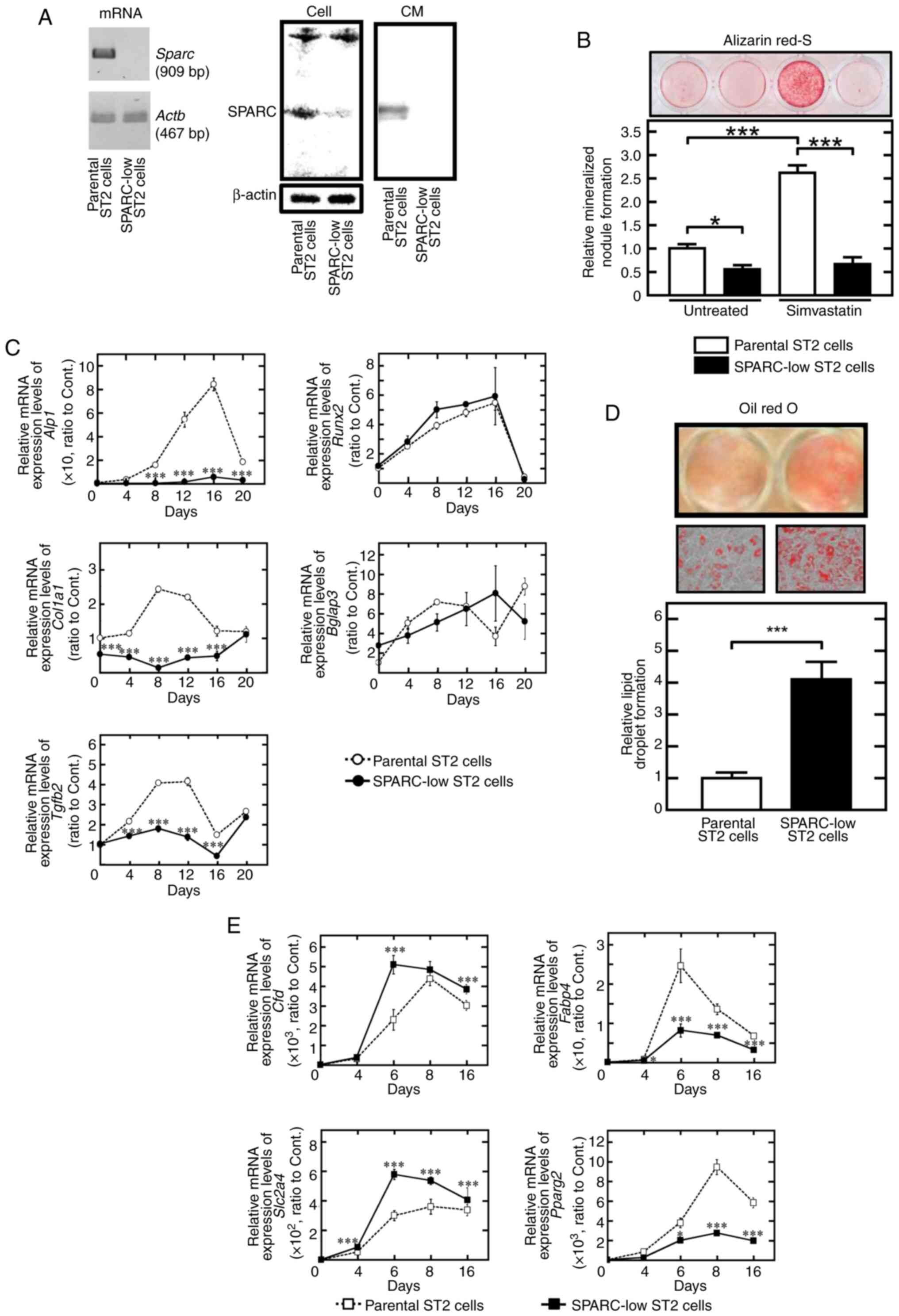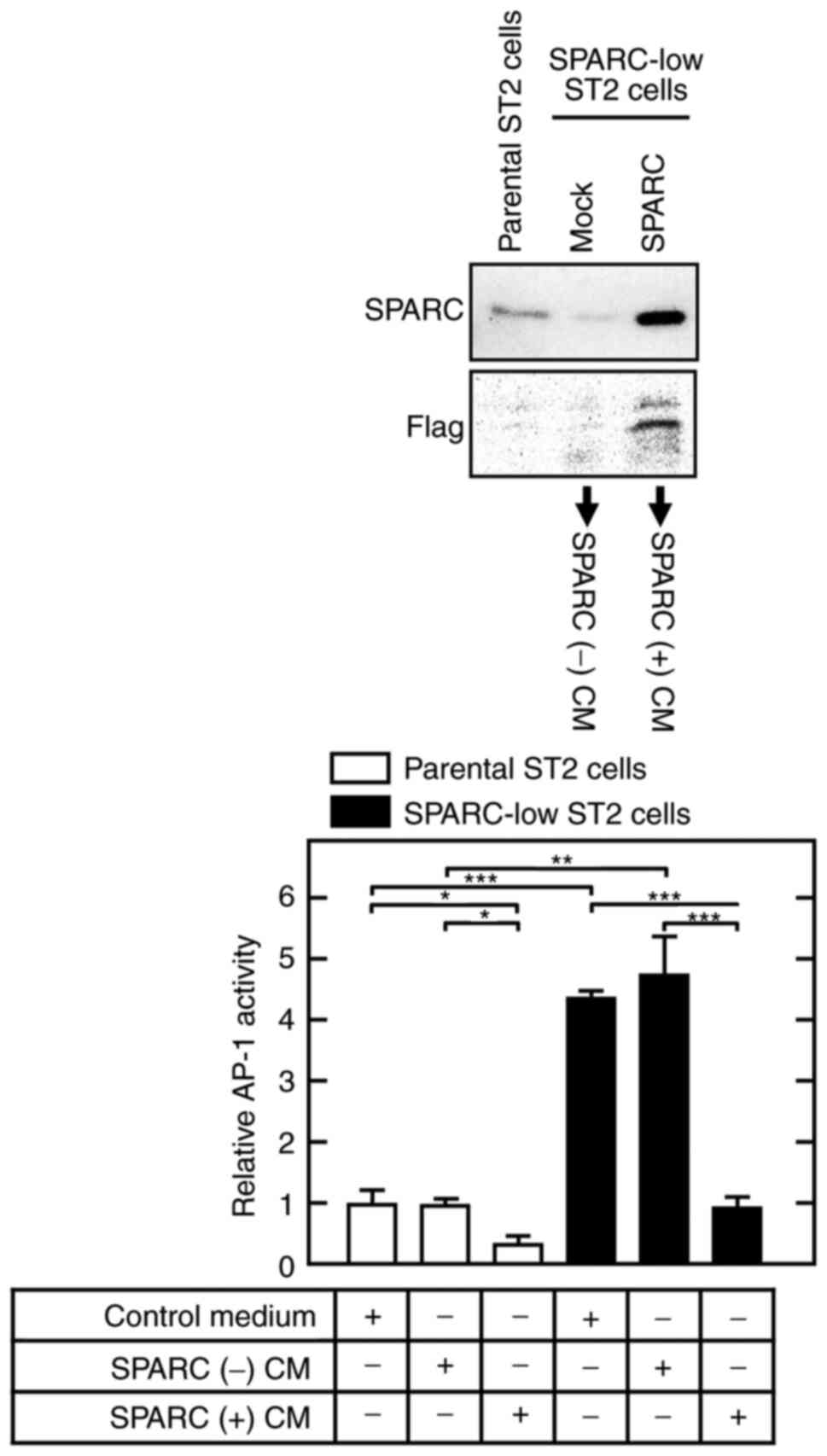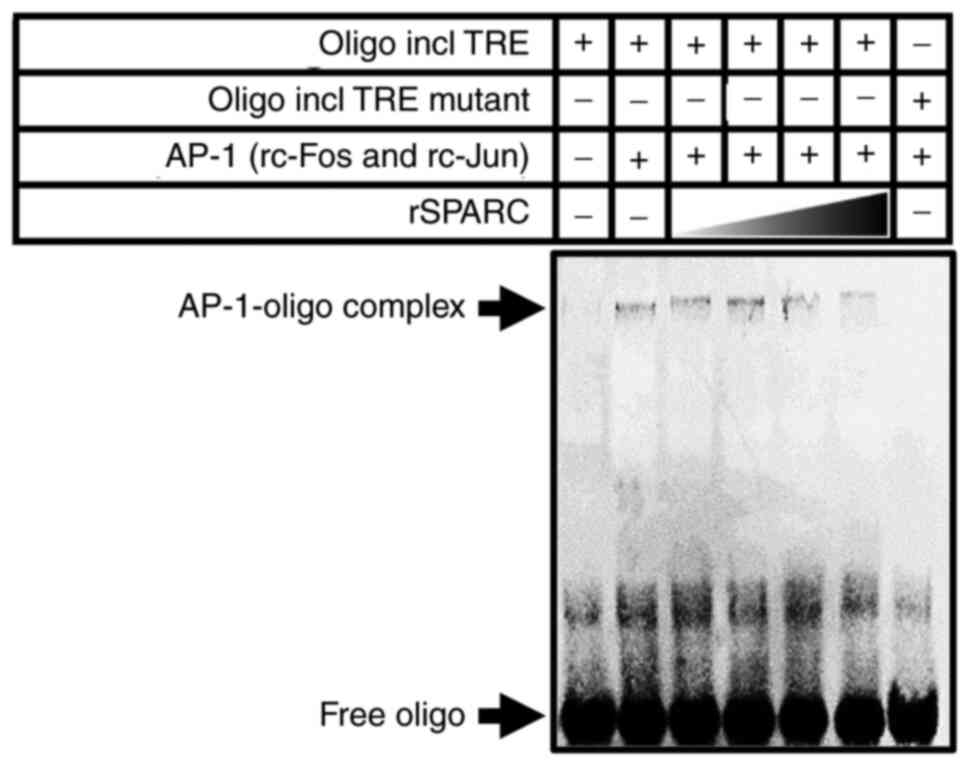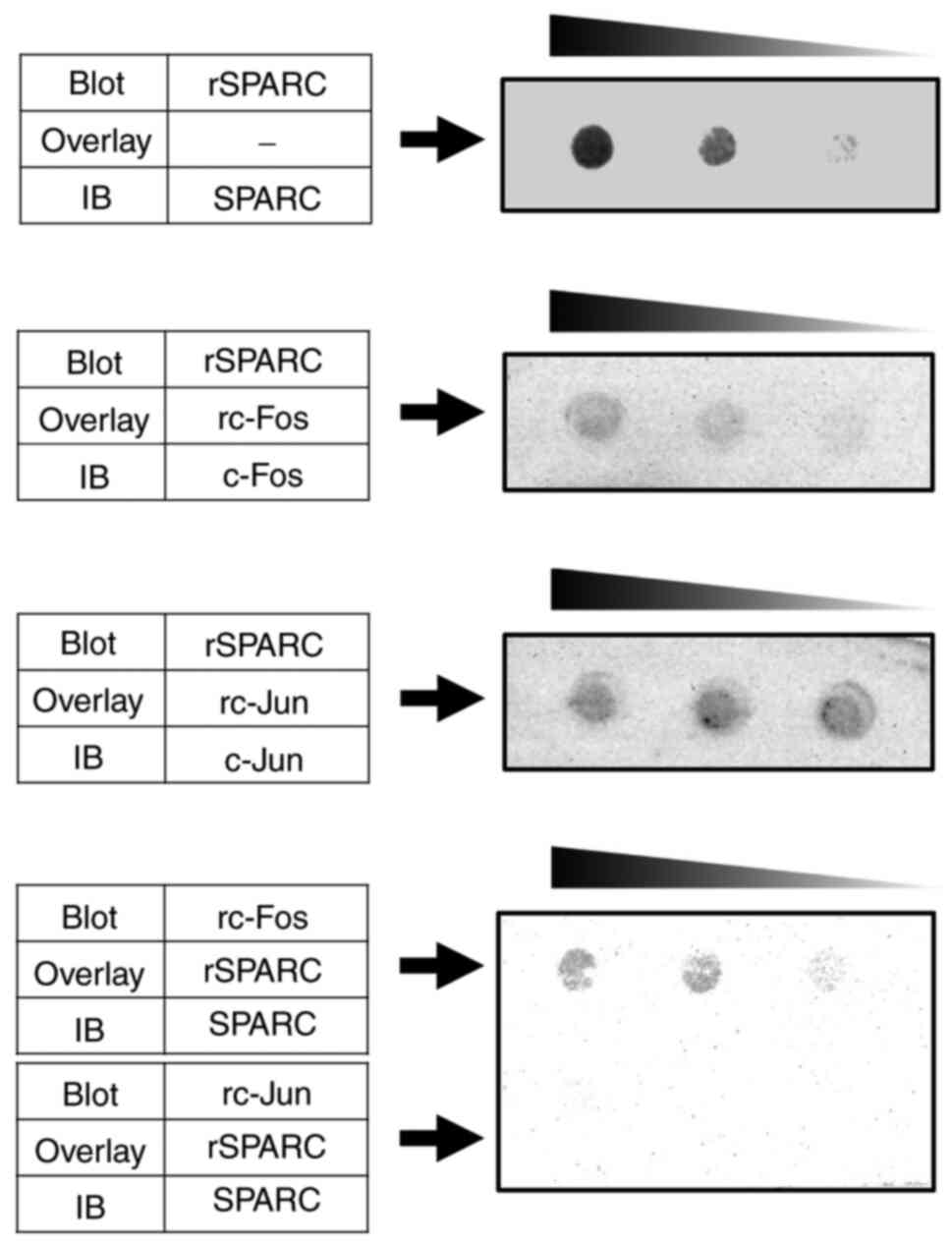|
1
|
Termine JD, Kleinman HK, Whitson SW, Conn
KM, McGarvey ML and Martin GR: Osteonectin, a bone-specific protein
linking mineral to collagen. Cell. 26:99–105. 1981. View Article : Google Scholar : PubMed/NCBI
|
|
2
|
Yan Q and Sage EH: SPARC, a matricellular
glycoprotein with important biological functions. J Histochem
Cytochem. 47:1495–1506. 1999. View Article : Google Scholar : PubMed/NCBI
|
|
3
|
Bradshaw AD: The role of SPARC in
extracellular matrix assembly. J Cell Commun Signal. 3:239–246.
2009. View Article : Google Scholar : PubMed/NCBI
|
|
4
|
Murphy-Ullrich JE and Sage EH: Revisiting
the matricellular concept. Matrix Biol. 37:1–14. 2014. View Article : Google Scholar : PubMed/NCBI
|
|
5
|
Giudici C, Raynal N, Wiedemann H, Cabral
WA, Marini JC, Timpl R, Bächinger HP, Farndale RW, Sasaki T and
Tenni R: Mapping of SPARC/BM-40/osteonectin-binding sites on
fibrillar collagens. J Biol Chem. 283:19551–19560. 2008. View Article : Google Scholar : PubMed/NCBI
|
|
6
|
Duncan S, Delage S, Chioran A, Sirbu O,
Brown TJ and Ringuette MJ: The predicted collagen-binding domains
of Drosophila SPARC are essential for survival and for collagen IV
distribution and assembly into basement membranes. Dev Biol.
461:197–209. 2020. View Article : Google Scholar : PubMed/NCBI
|
|
7
|
Cydzik M, Abdul-Wahid A, Park S, Bourdeau
A, Bowden K, Prodeus A, Kollara A, Brown TJ, Ringuette MJ and
Gariépy J: Slow binding kinetics of secreted protein, acidic, rich
in cysteine-VEGF interaction limit VEGF activation of VEGF receptor
2 and attenuate angiogenesis. FASEB J. 29:3493–3505. 2015.
View Article : Google Scholar : PubMed/NCBI
|
|
8
|
Gilmour DT, Lyon GJ, Carlton MB, Sanes JR,
Cunningham JM, Anderson JR, Hogan BL, Evans MJ and Colledge WH:
Mice deficient for the secreted glycoprotein SPARC/osteonectin/BM40
develop normally but show severe age-onset cataract formation and
disruption of the lens. EMBO J. 17:1860–1870. 1998. View Article : Google Scholar : PubMed/NCBI
|
|
9
|
Delany AM, Amling M, Priemel M, Howe C,
Baron R and Canalis E: Osteopenia and decreased bone formation in
osteonectin-deficient mice. J Clin Invest. 105:915–923. 2000.
View Article : Google Scholar : PubMed/NCBI
|
|
10
|
Bradshaw AD, Graves DC, Motamed K and Sage
EH: SPARC-null mice exhibit increased adiposity without significant
differences in overall body weight. Proc Natl Acad Sci USA.
100:6045–6050. 2003. View Article : Google Scholar : PubMed/NCBI
|
|
11
|
Delany AM, Kalajzic I, Bradshaw AD, Sage
EH and Canalis E: Osteonectin-null mutation compromises osteoblast
formation, maturation, and survival. Endocrinology. 144:2588–2596.
2003. View Article : Google Scholar : PubMed/NCBI
|
|
12
|
Francki A, Bradshaw AD, Bassuk JA, Howe
CC, Couser WG and Sage EH: SPARC regulates the expression of
collagen type I and transforming growth factor-beta1 in mesangial
cells. J Biol Chem. 274:32145–32152. 1999. View Article : Google Scholar : PubMed/NCBI
|
|
13
|
Yan Q, Weaver M, Perdue N and Sage EH:
Matricellular protein SPARC is translocated to the nuclei of
immortalized murine lens epithelial cells. J Cell Physiol.
203:286–294. 2005. View Article : Google Scholar : PubMed/NCBI
|
|
14
|
Gooden MD, Vernon RB, Bassuk JA and Sage
EH: Cell cycle-dependent nuclear location of the matricellular
protein SPARC: Association with the nuclear matrix. J Cell Biochem.
74:152–167. 1999. View Article : Google Scholar : PubMed/NCBI
|
|
15
|
Hecht JT and Sage EH: Retention of the
matricellular protein SPARC in the endoplasmic reticulum of
chondrocytes from patients with pseudoachondroplasia. J Histochem
Cytochem. 54:269–274. 2006. View Article : Google Scholar : PubMed/NCBI
|
|
16
|
Huynh MH, Hong H, Delovitch S, Desser S
and Ringuette M: Association of SPARC (osteonectin, BM-40) with
extracellular and intracellular components of the ciliated surface
ectoderm of Xenopus embryos. Cell Motil Cytoskeleton. 47:154–162.
2000. View Article : Google Scholar : PubMed/NCBI
|
|
17
|
Sodek J, Zhu B, Huynh MH, Brown TJ and
Ringuette M: Novel functions of the matricellular proteins
osteopontin and osteonectin/SPARC. Connect Tissue Res. 43:308–319.
2002. View Article : Google Scholar : PubMed/NCBI
|
|
18
|
Krstulja M, Car A, Bonifacić D, Braut T
and Kujundzić M: Nasopharyngeal angiofibroma with intracellular
accumulation of SPARC-a hypothesis (SPARC in nasopharyngeal
angiofibroma). Med Hypotheses. 70:600–604. 2008. View Article : Google Scholar : PubMed/NCBI
|
|
19
|
Fenouille N, Puissant A, Dufies M, Robert
G, Jacquel A, Ohanna M, Deckert M, Pasquet JM, Mahon FX, Cassuto
JP, et al: Persistent activation of the Fyn/ERK kinase signaling
axis mediates imatinib resistance in chronic myelogenous leukemia
cells through upregulation of intracellular SPARC. Cancer Res.
70:9659–9670. 2010. View Article : Google Scholar : PubMed/NCBI
|
|
20
|
Vinayagam A, Stelzl U, Foulle R, Plassmann
S, Zenkner M, Timm J, Assmus HE, Andrade-Navarro MA and Wanker EE:
A directed protein interaction network for investigating
intracellular signal transduction. Sci Signal. 4:rs82011.
View Article : Google Scholar : PubMed/NCBI
|
|
21
|
White UA and Stephens JM: Transcriptional
factors that promote formation of white adipose tissue. Mol Cell
Endocrinol. 318:10–14. 2010. View Article : Google Scholar : PubMed/NCBI
|
|
22
|
Karin M, Liu ZG and Zandi E: AP-1 function
and regulation. Curr Opin Cell Biol. 9:240–246. 1997. View Article : Google Scholar : PubMed/NCBI
|
|
23
|
Distel RJ, Ro HS, Rosen BS, Groves DL and
Spiegelman BM: Nucleoprotein complexes that regulate gene
expression in adipocyte differentiation: Direct participation of
c-fos. Cell. 49:835–844. 1987. View Article : Google Scholar : PubMed/NCBI
|
|
24
|
Knebel B, Kotzka J, Lehr S, Hartwig S,
Avci H, Jacob S, Nitzgen U, Schiller M, März W, Hoffmann MM, et al:
A mutation in the c-fos gene associated with congenital generalized
lipodystrophy. Orphanet J Rare Dis. 8:1192013. View Article : Google Scholar : PubMed/NCBI
|
|
25
|
Maeda T and Horiuchi N: Simvastatin
suppresses leptin expression in 3T3-L1 adipocytes via activation of
the cyclic AMP-PKA pathway induced by inhibition of protein
prenylation. J Biochem. 145:771–781. 2009. View Article : Google Scholar : PubMed/NCBI
|
|
26
|
Maeda T, Suzuki A, Yuzawa S, Baba Y,
Kimura Y and Kato Y: Mineral trioxide aggregate induces
osteoblastogenesis via Atf6. Bone Rep. 2:36–43. 2015. View Article : Google Scholar : PubMed/NCBI
|
|
27
|
Hirose K, Isogai E, Mizugai H and Ueda I:
Adhesion of Porphyromonas gingivalis fimbriae to human gingival
cell line Ca9-22. Oral Microbiol Immunol. 11:402–406. 1996.
View Article : Google Scholar : PubMed/NCBI
|
|
28
|
Ogawa M and Nishikawa S, Ikuta K, Yamamura
F, Naito M, Takahashi K and Nishikawa S: B cell ontogeny in murine
embryo studied by a culture system with the monolayer of a stromal
cell clone, ST2: B cell progenitor develops first in the embryonal
body rather than in the yolk sac. EMBO J. 7:1337–1343. 1988.
View Article : Google Scholar : PubMed/NCBI
|
|
29
|
Chomczynski P and Sacchi N: Single-step
method of RNA isolation by acid guanidinium
thiocyanate-phenol-chloroform extraction. Anal Biochem.
162:156–159. 1987. View Article : Google Scholar : PubMed/NCBI
|
|
30
|
Schmittgen TD and Livak KJ: Analyzing
real-time PCR data by the comparative C(T) method. Nat Protoc.
3:1101–1108. 2008. View Article : Google Scholar : PubMed/NCBI
|
|
31
|
Nagaoka M, Maeda T, Chatani M, Handa K,
Yamakawa T, Kiyohara S, Negishi-Koga T, Kato Y, Takami M, Niida S,
et al: A delphinidin-enriched maqui berry extract improves bone
metabolism and protects against bone loss in osteopenic mouse
models. Antioxidants (Basel). 8:3862019. View Article : Google Scholar : PubMed/NCBI
|
|
32
|
Dignam JD, Lebovitz RM and Roeder RG:
Accurate transcription initiation by RNA polymerase II in a soluble
extract from isolated mammalian nuclei. Nucleic Acids Res.
11:1475–1489. 1983. View Article : Google Scholar : PubMed/NCBI
|
|
33
|
Maeda T, Suzuki A, Koga K, Miyamoto C,
Maehata Y, Ozawa S, Hata RI, Nagashima Y, Nabeshima K, Miyazaki K
and Kato Y: TRPM5 mediates acidic extracellular pH signaling and
TRPM5 inhibition reduces spontaneous metastasis in mouse B16-BL6
melanoma cells. Oncotarget. 8:78312–78326. 2017. View Article : Google Scholar : PubMed/NCBI
|
|
34
|
Hellman LM and Fried MG: Electrophoretic
mobility shift assay (EMSA) for detecting protein-nucleic acid
interactions. Nat Protoc. 2:1849–1861. 2007. View Article : Google Scholar : PubMed/NCBI
|
|
35
|
Cornelius P, MacDougald OA and Lane MD:
Regulation of adipocyte development. Annu Rev Nutr. 14:99–129.
1994. View Article : Google Scholar : PubMed/NCBI
|
|
36
|
Maeda T, Kawane T and Horiuchi N: Statins
augment vascular endothelial growth factor expression in
osteoblastic cells via inhibition of protein prenylation.
Endocrinology. 144:681–692. 2003. View Article : Google Scholar : PubMed/NCBI
|
|
37
|
Garin-Shkolnik T, Rudich A, Hotamisligil
GS and Rubinstein M: FABP4 attenuates PPARγ and adipogenesis and is
inversely correlated with PPARγ in adipose tissues. Diabetes.
63:900–911. 2014. View Article : Google Scholar : PubMed/NCBI
|
|
38
|
Tseng C and Kolonin MG: Proteolytic
isoforms of SPARC induce adipose stromal cell mobilization in
obesity. Stem Cells. 34:174–190. 2016. View Article : Google Scholar : PubMed/NCBI
|
|
39
|
Kawakita F, Kanamaru H, Asada R and Suzuki
H: Potential roles of matricellular proteins in stroke. Exp Neurol.
322:1130572019. View Article : Google Scholar : PubMed/NCBI
|
|
40
|
Suzuki K, Zhu B, Rittling SR, Denhardt DT,
Goldberg HA, McCulloch CA and Sodek J: Colocalization of
intracellular osteopontin with CD44 is associated with migration,
cell fusion, and resorption in osteoclasts. J Bone Miner Res.
17:1486–1497. 2002. View Article : Google Scholar : PubMed/NCBI
|
|
41
|
Lynch JM, Maillet M, Vanhoutte D,
Schloemer A, Sargent MA, Blair NS, Lynch KA, Okada T, Aronow BJ,
Osinska H, et al: A thrombospondin-dependent pathway for a
protective ER stress response. Cell. 149:1257–1268. 2012.
View Article : Google Scholar : PubMed/NCBI
|
|
42
|
Grigoriadis AE, Wang ZQ, Cecchini MG,
Hofstetter W, Felix R, Fleisch HA and Wagner EF: c-Fos: A key
regulator of osteoclast-macrophage lineage determination and bone
remodeling. Science. 266:443–448. 1994. View Article : Google Scholar : PubMed/NCBI
|
|
43
|
Wang ZQ, Ovitt C, Grigoriadis AE,
Möhle-Steinlein U, Rüther U and Wagner EF: Bone and haematopoietic
defects in mice lacking c-fos. Nature. 360:741–745. 1992.
View Article : Google Scholar : PubMed/NCBI
|
|
44
|
Boyce BF, Yamashita T, Yao Z, Zhang Q, Li
F and Xing L: Roles for NF-kappaB and c-Fos in osteoclasts. J Bone
Miner Metab. 23 (Suppl 1):S11–S15. 2005. View Article : Google Scholar : PubMed/NCBI
|
|
45
|
Jochum W, David JP, Elliott C, Wutz A,
Plenk H Jr, Matsuo K and Wagner EF: Increased bone formation and
osteosclerosis in mice overexpressing the transcription factor
Fra-1. Nat Med. 6:980–984. 2000. View
Article : Google Scholar : PubMed/NCBI
|
|
46
|
Schwabe K, Garcia M, Ubieta K, Hannemann
N, Herbort B, Luther J, Noël D, Jorgensen C, Casteilla L, David JP,
et al: Inhibition of osteoarthritis by adipose-derived stromal
cells overexpressing Fra-1 in mice. Arthritis Rheumatol.
68:138–151. 2016. View Article : Google Scholar : PubMed/NCBI
|
|
47
|
Eferl R, Hasselblatt P, Rath M, Popper H,
Zenz R, Komnenovic V, Idarraga MH, Kenner L and Wagner EF:
Development of pulmonary fibrosis through a pathway involving the
transcription factor Fra-2/AP-1. Proc Natl Acad Sci USA.
105:10525–10530. 2008. View Article : Google Scholar : PubMed/NCBI
|
|
48
|
Kveiborg M, Sabatakos G, Chiusaroli R, Wu
M, Philbrick WM, Horne WC and Baron R: DeltaFosB induces
osteosclerosis and decreases adipogenesis by two independent
cell-autonomous mechanisms. Mol Cell Biol. 24:2820–2830. 2004.
View Article : Google Scholar : PubMed/NCBI
|
|
49
|
Hasenfuss SC, Bakiri L, Thomsen MK,
Williams EG, Auwerx J and Wagner EF: Regulation of steatohepatitis
and PPARγ signaling by distinct AP-1 dimers. Cell Metab. 19:84–95.
2014. View Article : Google Scholar : PubMed/NCBI
|
|
50
|
Wagner EF and Eferl R: Fos/AP-1 proteins
in bone and the immune system. Immunol Rev. 208:126–140. 2005.
View Article : Google Scholar : PubMed/NCBI
|
|
51
|
Luther J, Ubieta K, Hannemann N, Jimenez
M, Garcia M, Zech C, Schett G, Wagner EF and Bozec A: Fra-2/AP-1
controls adipocyte differentiation and survival by regulating PPARγ
and hypoxia. Cell Death Differ. 21:655–664. 2014. View Article : Google Scholar : PubMed/NCBI
|
|
52
|
Roschger P, Matsuo K, Misof BM, Tesch W,
Jochum W, Wagner EF, Fratzl P and Klaushofer K: Normal
mineralization and nanostructure of sclerotic bone in mice
overexpressing Fra-1. Bone. 34:776–782. 2004. View Article : Google Scholar : PubMed/NCBI
|
|
53
|
Cohen DR, Ferreira PC, Gentz R, Franza BR
Jr and Curran T: The product of a fos-related gene, fra-1, binds
cooperatively to the AP-1 site with Jun: Transcription factor AP-1
is comprised of multiple protein complexes. Genes Dev. 3:173–184.
1989. View Article : Google Scholar : PubMed/NCBI
|
|
54
|
Yan C, Wang H, Aggarwal B and Boyd DD: A
novel homologous recombination system to study 92 kDa type IV
collagenase transcription demonstrates that the NF-kappaB motif
drives the transition from a repressed to an activated state of
gene expression. FASEB J. 18:540–541. 2004. View Article : Google Scholar : PubMed/NCBI
|
|
55
|
Mansergh FC, Wells T, Elford C, Evans SL,
Perry MJ, Evans MJ and Evans BA: Osteopenia in Sparc
(osteonectin)-deficient mice: Characterization of phenotypic
determinants of femoral strength and changes in gene expression.
Physiol Genomics. 32:64–73. 2007. View Article : Google Scholar : PubMed/NCBI
|
|
56
|
Kos K, Wong S, Tan B, Gummesson A, Jernas
M, Franck N, Kerrigan D, Nystrom FH, Carlsson LM, Randeva HS, et
al: Regulation of the fibrosis and angiogenesis promoter
SPARC/osteonectin in human adipose tissue by weight change, leptin,
insulin, and glucose. Diabetes. 58:1780–1788. 2009. View Article : Google Scholar : PubMed/NCBI
|
|
57
|
Tartare-Deckert S, Chavey C, Monthouel MN,
Gautier N and Van Obberghen E: The matricellular protein
SPARC/osteonectin as a newly identified factor up-regulated in
obesity. J Biol Chem. 276:22231–22237. 2001. View Article : Google Scholar : PubMed/NCBI
|
|
58
|
Lee SH, Lee JA, Park HS, Song YS, Jang YJ,
Kim JH, Lee YJ and Heo Y: Associations among SPARC mRNA expression
in adipose tissue, serum SPARC concentration and metabolic
parameters in Korean women. Obesity (Silver Spring). 21:2296–2302.
2013. View Article : Google Scholar : PubMed/NCBI
|



















